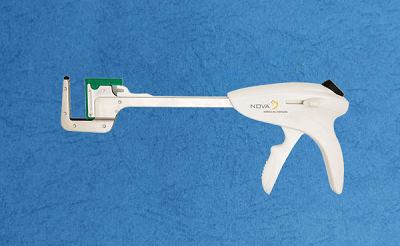Distal gastrectomy using single use stapler
In the Bi I type, a using gastroduodenal end-to-end anastomosis, so that the tension of the anastomosis formed is small. If the tension of the anastomosis is too large, The risk of anastomotic fistula will increase after the operation. The author believes that although the end-to-end anastomosis is complicated, as long as the blood supply at the anastomosis is sufficient and the tension-free anastomosis is ensured, there is no significant difference in the incidence of postoperative complications between the two anastomosis methods.
In the Bi-II style, a circular stapler (25-26mm) is generally used for anastomosis, and a linear cutting stapler can also be used. The author is accustomed to using the latter to complete the gastrojejunal anastomosis. The duodenum can be used with an endoscopic linear cutting stapler (45mm ) Cut off. This type of stapler has 6 rows of staples. The suture has a good hemostasis function. It is not easy to form duodenal stump fistula and bleeding after the operation. If the duodenal stump edema is obvious, you can switch to manual suture, and then Use the endoscopic linear cutting stapler (45mm) to complete the gastro-jejunum side-to-side anastomosis. During the anastomosis, note that the jejunum-to-mesangial margin should be tightly attached to the gastric wall of the remnant stomach. Do not bring the mesenteric tissue into the anastomosis, otherwise it is easy to damage the mesenteric blood vessels. Causes tissue ischemia at the anastomosis and anastomotic leakage. In order to prevent complications after the Bi Ⅱ anastomosis, an inter-jejunal side-to-side anastomosis (Braun anastomosis) can be performed on this basis. The Bi Ⅱ anastomosis is often followed by an anastomosis. Alkaline reflux gastritis and anastomotic stomatitis are prone to occur, so I mostly use Bi Ⅰ or Roux-en-Y anastomosis.

Total gastrectomy using single use stapler
Esophageal jejunal anastomosis and jejunal gastric replacement can be used. Colon replacement and esophageal jejunal Roux-en-Y anastomosis. Esophageal-jejunal anastomosis is simple and time-saving, but the postoperative intestinal fluid reflux symptoms are more convenient. Stomach replacement can significantly improve the quality of life of the patient, but the operation is complicated. The esophagus-jejunal Roux-en-Y anastomosis is difficult to perform and moderate, and it can improve the reflux symptoms. The surgeon can choose according to the patient's condition and experience. For a suitable reconstruction method, the author recommends Roux-en-Y anastomosis of the esophagus and jejunum. A circular stapler (25-26mm) can be used to complete the anterior colonic esophagus and jejunum end-to-side anastomosis, and a linear cutting stapler (such as 45mm) can be used to complete the proximal and distal jejunum side. After anastomosis, the stump of the jejunum was closed with 45.
Post time: Nov-26-2021





